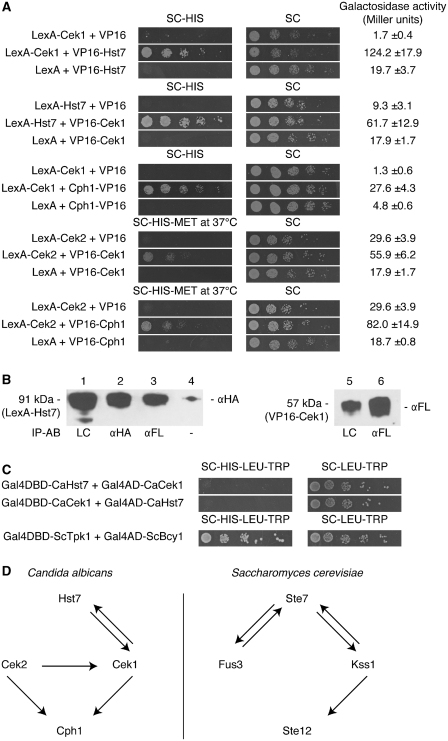Figure 4.
Interactions between downstream targets of the mating/filamentation MAP kinase pathway. (A) All pair-wise combinations of interactions between the MAPKK Hst7, the MAP kinases Cek2 and Cek1, and the transcription factor Cph1 were tested in a two-hybrid assay. Interactions between the proteins pairs Hst7 and Cek1, Cek2 and Cek1, Cek1 and Cph1, and Cek2 and Cph1 were detected. In all cases, a representative transformant is shown for growth for up to 5 days on SC–HIS. At least two independent transformants were used for the galactosidase assay. (B) The interaction between bait LexA–HA–Hst7 (91 kDa) and prey VP16–FLAG–Cek1 (57 kDa) is confirmed in a co-immunoprecipitation (co-IP) experiment. Total protein concentrations were equal for each sample. Lane 1: loading control of Hst7; lane 2: IP of Hst7 with anti-HA antibodies; lane 3: co-IP of Hst7 with anti-FLAG antibodies, visualized with anti-HA antibodies; lane 4: negative control of Hst7 with beads but without antibodies; lane 5: loading control of Cek1; lane 6: IP of Cek1 with anti-FLAG antibodies. IP-AB: antibody used for immunoprecipitation; LC: loading control; αFL: anti-FLAG antibody; αHA: anti-HA antibody. (C) Yeast two-hybrid experiment with Hst7 and Cek1 after 7 days on selective medium. The interacting S. cerevisiae protein pair Bcy1 with Tpk1 was used as positive control. (D) Comparison of pair-wise interactions of C. albicans proteins as shown by a C. albicans two-hybrid experiment (A) and of S. cerevisiae proteins demonstrated in the yeast two-hybrid assay (48,54–56). Arrows are directed from the bait protein to the prey protein.

